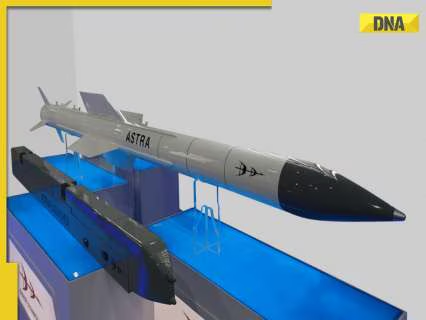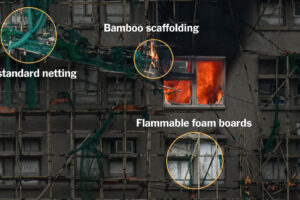
As per the new proposals, the missile’s range will be increased well beyond its earlier 160 km limit, giving it much longer reach. The Indian Air Force (IAF) plans to order about 700 upgraded Astra missiles, which will be fitted on its Sukhoi Su-30MKI and Tejas fighter jets.
In a major step to boost India’s air power, the DRDO is planning to extend the range of its Astra Mark-2 air-to-air missile to over 200 km. This means the indigenous missile will soon be able to hit enemy aircraft from much longer distances, greatly increasing the Indian Air Force’s combat strength. As per the new proposals, the missile’s range will be increased well beyond its earlier 160 km limit, giving it much longer reach. The Indian Air Force (IAF) plans to order about 700 upgraded Astra missiles, which will be fitted on its Sukhoi Su-30MKI and Tejas fighter jets.
This move comes after India’s focus on indigenous weapons grew stronger following Operation Sindoor, where IAF pilots successfully used earlier Astra missiles in beyond-visual-range (BVR) combat. The Astra Mk-2 missile is being made to match and counter China’s powerful PL-15 missile, which has approximately 200km range. Defence officials said the 200 km+ range is crucial for safety, as it lets Indian pilots destroy enemy aircraft from a safe distance, without entering the enemy’s missile range. It means Indian pilots can launch their missiles from a safe distance, staying outside the range where enemy missiles could target or harm them.
BVR (Beyond Visual Range) combat means air battles where pilots can attack enemy aircraft from long distances — usually beyond 30 to 50 km — without seeing them directly, using radar-guided missiles. Both the Astra Mk-2 and China’s PL-15 missile use a dual-pulse solid rocket motor. This means the missile’s engine has two separate fuel sections. The first pulse gives a strong push (initial thrust) at launch to make it fly fast, and the second pulse fires later in the final stage, giving it another burst of power to chase and hit a target far away. This helps the missile stay fast and accurate over long distances.
The Astra Mk-2 uses several advanced Indian parts, notably a modern seeker and a fibre-optic gyroscope, which together give better resistance to electronic countermeasures (ECM). The seeker is the missile’s “eye” (a sensor that finds and locks onto the target using radar or imaging — radar sends radio waves and detects reflections to find an object’s distance and speed; imaging works like a camera or infrared sensor to “see” and identify the target). The fibre-optic gyroscope is a very accurate motion sensor (it tells the missile which way it is pointing and corrects its path without relying on GPS). ECM means enemy attempts to jam or confuse the missile’s sensors; these new parts help the Astra ignore such interference and stay on target.
The Astra Mk-2, with a range of over 200 km, will have a clear edge over China’s export PL-15E (used by Pakistan) which is capped at about 145 km, while the Chinese domestic PL-15 variant is reported to have a range near 200 km. Pakistan uses AMRAAMs on its F-16 Block-52 fighters, with the AIM-120C variant having a range of about 105–120 km, while the AIM-120D version can reach 160–180 km. The upgrade would make the Astra Mk-2 as good as or better than the main BVR missiles in the region — thanks to longer range, dual-pulse motor and improved standoff ability (means Indian pilots can fire from a safe distance so enemy weapons cannot reach them).
Although DRDO has not officially revealed the exact upgrade plan, experts believe extending Astra’s range from 160 km to over 200 km is technically achievable. The dual-pulse motor technology, already proven in the American AMRAAM (Advanced Medium-Range Air-to-Air Missile) — a widely used U.S. missile known for its precision and reliability — enables the missile to fly efficiently and save energy for long-range attacks, Defence.in reported. Analysts say the range boost can come two ways: improve the propellant so the same missile gets more energy, or make the missile slightly bigger to carry extra fuel. The bigger missile option may cause fit and weight problems on lighter jets like the Tejas, so engineers prefer changing the propellant formulation if possible.
The Astra missile programme is a key part of India’s Aatmanirbhar Bharat push in defence. The earlier Astra Mk-1, with a range of over 100 km, is combat-proven and in service. As testing continues, the Astra Mk-2 upgrade marks an important step in strengthening India’s air defence strategy and reducing reliance on expensive foreign missiles.
(The author of this article is a Defence, Aerospace & Political Analyst based in Bengaluru. He is also Director of ADD Engineering Components, India, Pvt. Ltd, a subsidiary of ADD Engineering GmbH, Germany. You can reach him at: girishlinganna@gmail.com)
(Disclaimer: The views expressed above are the author’s own and do not reflect those of DNA)





